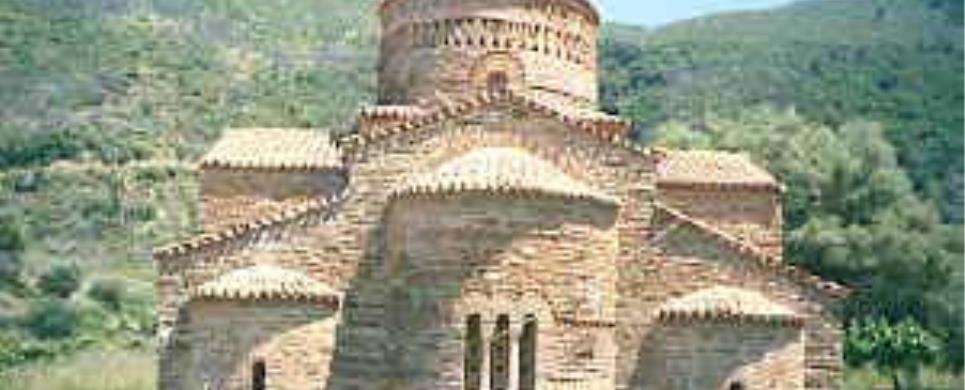Listed 7 sub titles with search on: Sights for wider area of: "NAFPAKTOS Municipality ETOLOAKARNANIA" .

NAFPAKTOS (Town) ETOLOAKARNANIA
Several architectural phases are distinguished in the fortification
walls of Naupactos, dated from the Greek antiquity until the Turkish occupation.
Two walls run down the slope of the hill, starting from the top, one towards the
east, and the other towards the west. Before they reach the coast, they form an
angle and block the entrance to the harbour. Four transverse walls join these
two, thus forming five sections. The enceinte is reinforced with rectangular and
circular towers.
The castle is built on the site of the ancient acropolis. Naupactos
was destroyed by an earhtquake in A.D.553 and from the 8th century on, it became
the capital of the fifth Theme of Byzantium. It remained under Greek control until
1204, when it was given away to the Venetians. In 1210, Michael Angelos Comnenos
included the city in the properties of the Despotate of Epiros. In 1294 it came
under the control of Philip d'Anjou and in 1360 was conquered by the Albanian
leader, Ghino Buo Spata. From 1407 until 1444 it was occupied by the Venetians
and then by the Turks, who kept it until 1687. From 1687 until 1699 it was again
under the Venetian control and remained under Turkish domination until 1829.
The site has not been systematically excavated. The trenches opened
in 1980-81 to the north of the church of Prophetes Elias brought to light the
remains of a Byzantine bath and a Byzantine church.
Cleaning and consolidation work is conducted every year by the 8th
Ephorate of Byzantine and Classical Antiquities. The crumbling sections of masonry
are repaired and the foundations in all parts of the wall that present stability
problems are restored.
As well, significant is the Clock
Bell-tower:
A square building
made of dressed stone terminating in a cornice likewise of stone. On two sides
hang the two round faces of the clock. Above it are four little pillars of brickwork,
connected by semi-circular apses. It was built at the beginning of this century
on the site of the Byzantine fortress (castro) of Naupaktos. The site is prominent
and the bell-tower is a fine example of a particular category of architecture.
In 1991 the clock was repaired.
Several architectural phases are distinguished in the fortification
walls of Nafpaktos, dated from the Greek antiquity until the Turkish occupation.
Two walls run down the slope of the hill, starting from the top, one towards the
east, and the other towards the west. Before they reach the coast, they form an
angle and block the entrance to the harbour. Four transverse walls join these
two, thus forming five sections. The enceinte is reinforced with rectangular and
circular towers.
History
The castle is built on the site of the ancient acropolis. Nafpaktos
was destroyed by an earhtquake in A.D. 553 and from the 8th century onwards, it
became the capital of the fifth Theme of Byzantium. It remained under Greek control
until 1204, when it was given away to the Venetians. In 1210, Michael Angelos
Comnenos included the city in the properties of the Despotate of Epiros. In 1294
it came under the control of Philip d'Anjou and in 1360 it was conquered by the
Albanian leader, Ghino Buo Spata. From 1407 until 1444 it was occupied by the
Venetians and then by the Turks, who kept it until 1687. From 1687 until 1699
it was again under the Venetian control and remained under Turkish domination
until 1829.
The site has not been systematically excavated. The trenches that
were opened in 1980-81 to the north of the church of Prophetes Elias brought to
light the remains of a Byzantine bath and a Byzantine church.
Cleaning and consolidation work is conducted every year by the 8th
Ephorate of Byzantine and Classical Antiquities. The crumbling sections of masonry
are repaired and the foundations in all parts of the wall that present stability
problems are restored.
This text is cited December 2004 from the West Greece Region General Secretariat URL below, which contains images.

GAVROLIMNI (Village) NAFPAKTOS
The
church belongs to the domed, cross-in-square type and, more specifically to
the "Helladic transitional type". The walls are built of limestone blocks enclosed
with bricks. The high, elegant dome is richly decorated with brick and tile ornaments
on the outside. Few traces of the wall paintings are preserved on the interior.
The church has three entrances in the narthex but very few windows are opened
in the walls.
The church was the catholicon (main church) of a Byzantine monastery,
dated by Orlandos to the end of the 10th century. On the basis of its architectural
features (tripartite narthex, carefully built wall masonry, decoration of the
dome, proportions of the window of the central apse), it is more securely dated
to the last quarter of the 10th century A.D.
Two trenches opened in 1983 in the foundations of the church revealed
the original threshold of the north door and its foundation, as well as numerous
burials. The foundations of the building and the outer pavement were restored
in 1983. Later, in 1990, the roof was reconstructed and the joints in the wall
masonry were repaired. By that time the restoration of the monument was completed.
In a recent investigation of the area around the church, 13 fragments
of sculpture were recorded. They are dated to the Early Christian period and they
bear evidence for the existence of an Early Christian basilica on the site.
NAFPAKTOS (Town) ETOLOAKARNANIA
Receive our daily Newsletter with all the latest updates on the Greek Travel industry.
Subscribe now!